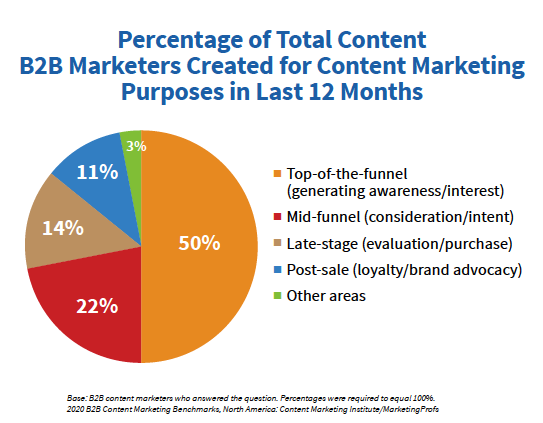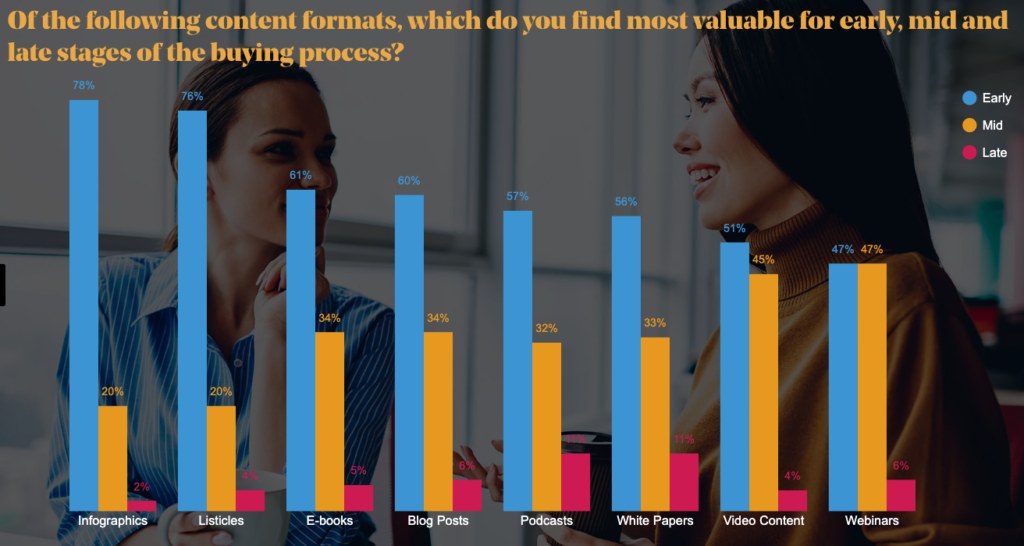Imagine that you’ve booked a trip to Italy with a tour company that’s promised an itinerary that includes all the sites from Vatican City to the canals of Venice. You arrive in Rome and pile onto a bus with 25 fellow travelers. The bus takes you to the first site on your tour, the Colosseum. The driver drops you off and says, “Thanks for joining us. Did we mention that you’re on your own from here on out? Have a good time.”
Focusing your content marketing on the beginning of the buyer’s journey, the top of the funnel, is a little like a tour company leaving you stranded at the Roman Colosseum one day into your 10-day tour. While it’s a bit of an exaggeration, marketers are focusing too much on the top of the funnel and leaving buyers to motivate themselves to go further.
Shifting the Funnel Focus
The B2B Content Marketing 2020: Benchmarks, Budgets, and Trends—North America report published by the Content Marketing Institute and Marketing Profs found that content marketing goals are still focused mostly on top-of-the-funnel goals. In fact, 50% of the content they created during the prior 12 months was for audiences in the early stages of the buyer’s journey.

The good news is that the trend is toward expanding content marketing to the middle and the bottom of the funnel — and into customer retention and loyalty. Using content marketing to nurture leads is up 10% over last year to 68%, generating sales/revenue is up 8% from last year to 53% and building customer loyalty is up 9% over last year to 63%.
Make sure you’re part of this trend by starting now to expand your content marketing across the top, middle and bottom of the funnel — and beyond.
If you want to guide your buyers along their entire journey, here are some tips.
Start With a Content Audit
Before you start creating new content, it’s a good idea to take stock of where you are today.
- Identify content that’s still fresh that you can continue to use as is.
- Look for early-stage content that could be easily repurposed to become middle stage.
- See how much and what types of content you need to create to fill gaps.
Is most of your content static? Do you tend to keep cranking out the same formats — for example, blog posts, e-books and infographics? Does the content you have align with the stage of the buyer’s journey you’re targeting?
Check out my blog post, Gap Analysis: Do You Know Where Your Content Is? for a more in-depth discussion of the power of a content audit.
Create Content to Follow the Funnel
We know that buyers will take many twists and turns on their journey, and they have varying preferences as they move from awareness to consideration to selection. Here’s what the latest research from the 2019 Content Preferences Survey Report shows.
In the early stage or top of the funnel, B2B buyers preferred short-form assets like infographics (78%), listicles (76%) and e-books (61%). These assets can be easily consumed and give buyers just enough information to set the foundation for their solution search. You can view these short-form assets as teasers that whet the buyer’s appetite for more meaty content. So include links to more in-depth content to move into the next stage of the journey. Also, keep in mind that the preference for infographics and listicles shows that B2B buyers like visuals and interactive content.
Interactivity actually becomes even more important moving into the middle of the funnel. Here, the preferences were for assessments (51%), webinars (47%) and any interactive content (50%). This makes sense as buyers are looking for information to help them evaluate their needs and what the market offers in terms of solutions to match those needs.
Late-stage content formats need to focus tightly on solution-specific information and real results. ROI calculators (42%), user reviews (49%) and case studies (34%) emerge at the top of the preference list here. You can see some of the other content formats that perform well at each stage in the following chart.

Don’t Stop at the Bottom of the Funnel
Content marketing shouldn’t stop at the bottom of the funnel. Connecting marketing automation and CRM has continued to blur the lines between marketing and sales, with marketing becoming more accountable for contributing to revenue. When it comes to content marketing, you need to create content to help your sales team sell to new customers, cross-sell and upsell to existing customers, and help retain existing customers and strengthen loyalty.
You can help sales by creating internal sales enablement tools like sales decks, battle cards and campaign toolkits. External content can include solution briefs, webcasts, podcasts and video.
Set Your 2020 Content Marketing Strategy Now
As we approach the new year, it’s a perfect time to plan your content marketing strategy. Make a resolution to stick with your buyers from their first steps on the buying journey to reinforcing their decision after the sale. Guide them through the funnel, and don’t leave them stranded.
As you round out your content to help your buyers find what they need at every stage of their journey, you may consider a content hub that gives them the power to move themselves down the funnel. Check out Tonya Vinas’ recent blog post, Content Hubs Are Great. Here’s How to Make Them Better.



